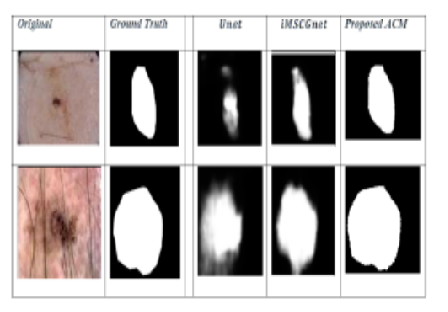


Indian Journal of Science and Technology
DOI: 10.17485/IJST/v16i46.1215
Year: 2023, Volume: 16, Issue: 46, Pages: 4378-4387
Original Article
Ramya Srikanteswara1*, A C Ramachandra2
1Assistant Professor, Department of CS&E, Nitte Meenakshi Institute of Technology, Bengaluru, Karnataka, India
2Professor & Head, Department of ECE, Nitte Meenakshi Institute Of Technology, Bengaluru, Karnataka, India
*Corresponding Author
Email: [email protected]
Received Date:19 May 2023, Accepted Date:27 September 2023, Published Date:15 December 2023
Background/Objectives: Melanoma cases have taken a sharp rise in recent years all across the world which is the reason of concern for many health institutions and the most concerning subject for many medical experts is its high mortality rate which causes thousands of lives every year. The main objective is to develop and evaluate a new system which can detect melanoma at an earlier stage. Methods: An efficient lesion segmentation method is introduced for the detection of Melanoma skin cancer disease at the preliminary stages using Adaptive Contour Model (ACM). The dataset used here is PH2 and ISIC Challenge 2017 Dataset images. 800 images are considered for the testing. High-quality segmentation is achieved based on contour features and sharp edge detection using ACM. An image is segregated into two set functions to analyze PH2 and ISIC Challenge 2017 Dataset images. Findings: The performance of the proposed Adaptive Contour Model (ACM) is tested upon PH2 and ISIC Challenge 2017 Dataset. The Performance matrices for the segmentation process are index (JA) is 79.23, the Dice coefficient (DI) is 87.26, and the accuracy (AC) is 94.63 considering ISIC dataset. The performance indices are such as index (JA) is 89.14, the Dice coefficient (DI) is 93.98, and the accuracy (AC) is 96.95 which is quite high considering PH2 dataset. Novelty: A method for detection of melanoma has been the critical need of the day. There are various findings available for segmentation of a medical image. However, there is a need for a method where it is applicable when the threshold based method may not be effective. This proposed method shows that the performance of the Active Contour Model (ACM) is more than 95%, which is better than other methods which lie around 92 to 94 percent.
Keywords: Contour Features, Adaptive Contour Model, Lesion Segmentation, Melanoma, Dermoscopic Images
© 2023 Srikanteswara & Ramachandra. This is an open-access article distributed under the terms of the Creative Commons Attribution License, which permits unrestricted use, distribution, and reproduction in any medium, provided the original author and source are credited. Published By Indian Society for Education and Environment (iSee)
Subscribe now for latest articles and news.